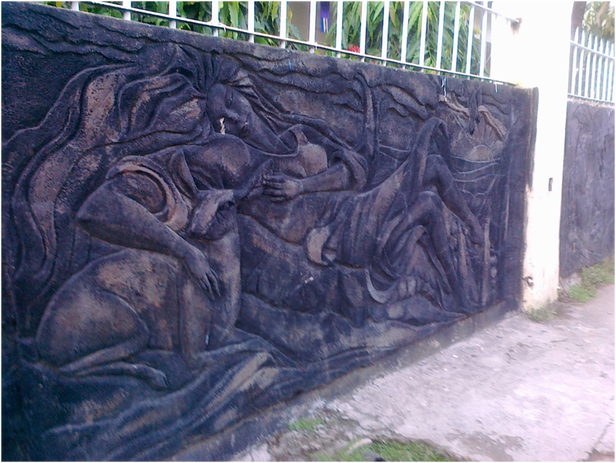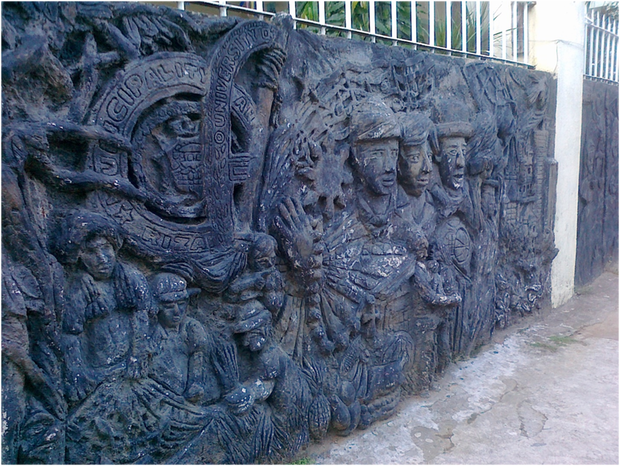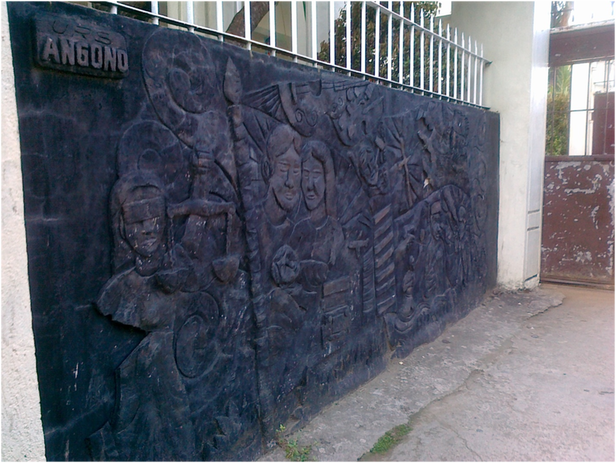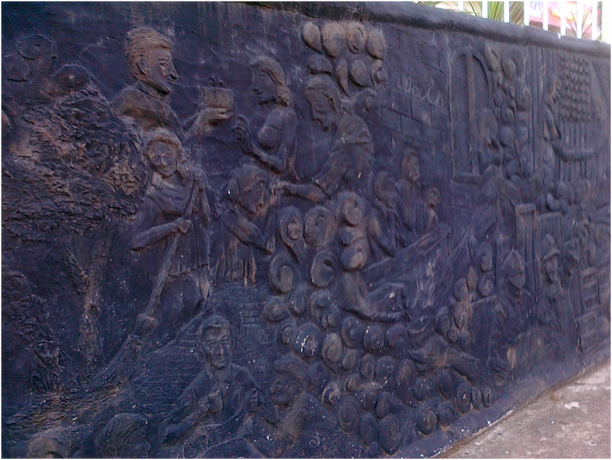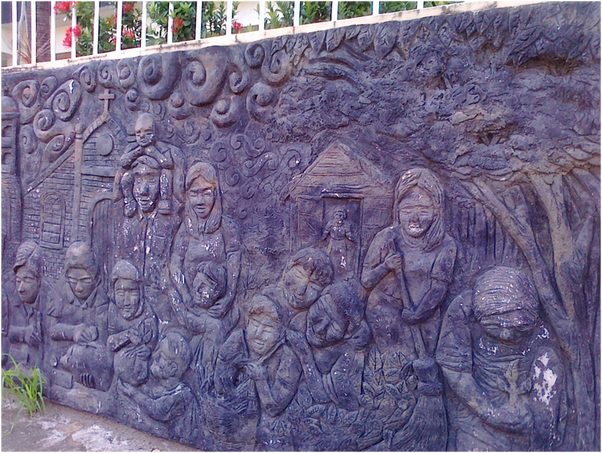UNIVERSITY OF RIZAL SYSTEM-ANGONO WALL ART
Anywhere and everywhere in Angono, art can be found. This sculpture on the wall can be seen even in the fences of residential houses. They consider it as a deep expression of their views and feelings done through art works.
At the center of the sculpture is a woman. For the people of Angono, women plays an important role. For them, women are as valuable as the man also. Even in the olden times women are productive in their town. They are not like the typical women of the old times who just stayed home to take care of the children. It they stay home, they also earn a living through their skills. Very prominent in the works of women there is the so called smacking, a kind of sawing which puts design in baby dresses, lady blouses and skirts. Their craftsmanship can be seen in the intricate and difficult designs such as flowers, boarders and others with the use of colorful threads. Before it is sewn, the sewer will have to draw it first on the clothes to have a format to follow.
Even with their famous celebration of the Resurrecion of Christ every Easter Sunday, the highlight is a very artistic dance of two ladies whom they call the Kapitana and the Tinienta. It exhibits the talent and skills of the ladies in bending their bodies while holding a banderita (small flags). The dance is being taught and practice throughout the year with a now old woman who is the trainer. Nights before the actual celebration, the two ladies visit each barangay to show to the people the dance which they have perfected as a sort of practice. The ladies spend for at least five gorgeous Filipiniana gowns for this affair. Ladies are selected for the next year through draw lots of the names given by the different barangays.
At the center of the sculpture is a woman. For the people of Angono, women plays an important role. For them, women are as valuable as the man also. Even in the olden times women are productive in their town. They are not like the typical women of the old times who just stayed home to take care of the children. It they stay home, they also earn a living through their skills. Very prominent in the works of women there is the so called smacking, a kind of sawing which puts design in baby dresses, lady blouses and skirts. Their craftsmanship can be seen in the intricate and difficult designs such as flowers, boarders and others with the use of colorful threads. Before it is sewn, the sewer will have to draw it first on the clothes to have a format to follow.
Even with their famous celebration of the Resurrecion of Christ every Easter Sunday, the highlight is a very artistic dance of two ladies whom they call the Kapitana and the Tinienta. It exhibits the talent and skills of the ladies in bending their bodies while holding a banderita (small flags). The dance is being taught and practice throughout the year with a now old woman who is the trainer. Nights before the actual celebration, the two ladies visit each barangay to show to the people the dance which they have perfected as a sort of practice. The ladies spend for at least five gorgeous Filipiniana gowns for this affair. Ladies are selected for the next year through draw lots of the names given by the different barangays.
This sculpture shows the collaboration of different agencies and organizations in the town. Shown are the zeal or logos of two important entities in the town, the Local Government Unit of Angono and the University of Rizatl System (URS), a state university in the province of Rizal. Significantly, URS has 10 campuses located in the different towns in Rizal. With their Campus Rationalization Program, the flagship of the campus located in Angono is Music, Culture and Arts, to cater to the interest and talents of the people of Angono and to provide them with their educational needs related to these areas and disciplines.
This sculpture also depicts the role of women in the community. Very salient here is the blindfolded woman carrying the scale balance. This depicts the artist’s love for justice. Angono people are peace-loving individuals. The rate of crime is very low. One can safely walk in the streets even late at night and early in the morning without getting afraid. It is also because people can be found in the streets in 24 hours a day, doing their activities to earn a living, like cooking and selling foods even in front of their houses. So anyone can buy food anytime of the day not needing to look for restaurants because native foodstuffs can be found just in the streets or in their neighborhood. Very popular there is there are their fried itik (goose specie), kumanoy ( a soft and sticky native delicacy cooked in coconut milk) and many others.
Peace prevails in the town, mainly because the people are with good character molded through their love for music, arts and culture, which develop in them a deep humanity.
Peace prevails in the town, mainly because the people are with good character molded through their love for music, arts and culture, which develop in them a deep humanity.
This sculpture shows the various occupations the Angono people are engaged with like fishing, sewing, and many others. It also displays some of their common activities like cleaning, the people of Angono are also very meticulous with cleanliness, orderliness and so they have mastered their household chores.
This sculpture depicts the religiousity of the Angono folks. People regularly go to the church on Sundays. Their church and religious activities are already tourist attraction of the province.
Created By: Hazelle Anne M.Estrabo
